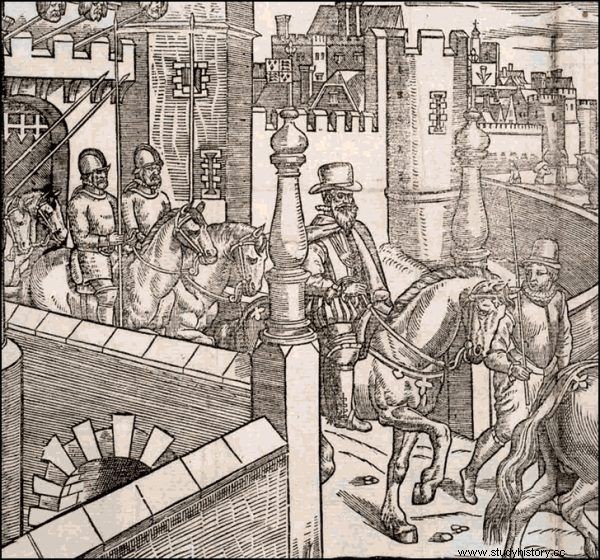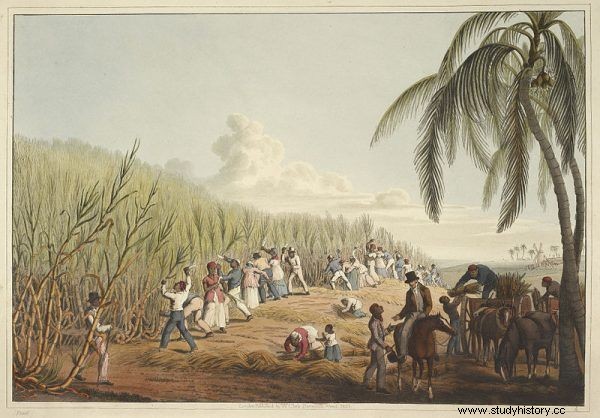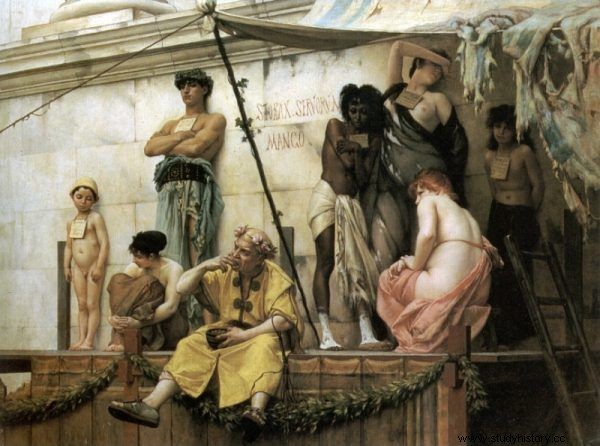Chained and forced to backbreaking work on plantations, where they died of exhaustion and disease. This was the fate not of those who were enslaved by the English as a result of their colonial activities in the heart of Africa, but of their own people.
English historians over the years belittled the contribution of slaves to the development of the British economy. The thing is, it was quite the opposite. Before the British chained the thousands of blacks whose work fueled the building and development of the empire, for years the foundation of slavery was white. History forgot about this surprising phenomenon. Who were the first who were forced into slave labor by the English for their own benefit?
The British were worse than Hitler
" What Britain did to the Irish in 800 years is worse than what Hitler did to the Jews, only the British gave themselves more time to do it "Said politician Ken Livingstone, MP in the House of Commons (1987-2001) and Mayor of London from 2000-2008. These words caused quite a storm and brought back the debate about the dark history of the British Empire.
It all started around the 16th century. The Irish were the first to fall victim to British greed. During the Tudor dynasty, the territory of Ireland was subject to mass colonization. The Catholic distinctiveness and the Celtic culture of the Irish were a real eye-catcher for the English. There were many revolts and protests against the occupiers on the "green island", but all of them were bloodily suppressed by the hegemons from London.
With the colonization of the island, the English began to discriminate against the indigenous peoples. In Irish cities, Catholics were removed from the community, their land was taken from them, their families were displaced. All attempts to resist were also strangled. British historian, Harvard professor Niall Ferguson wrote that "Ireland has become the experimental laboratory of British colonization." It was in Ireland that the English began to practice slavery on a large scale.

The first victims of British greed were the Irish. Mass colonization began in Tudor times. Illustrated by Henry Sidney, British envoy for Elizabeth I, departing from the Dublin Fortress (1581).
In the 1720s, English entrepreneurs who occupied Irish lands signed special agreements with local peasants living in poverty. They were promised land to own, but under strict conditions. On the basis of the "contract", a resident of a village for five years became the so-called a contract servant.
Behind this seemingly innocent name was slave labor. Immediately after signing the contract, the Irish peasant was sent to English estates overseas. There, on the island of Barbados, a real hard labor awaited the Irishman. Upon arrival, the unaware employee was shocked. The statement that the working conditions were inhumane does not even partially reflect the dread of the situation.
Whites in Barbados!
The first problems of the Irish peasant appeared on the ship that was supposed to transport him overseas. The British emphasized that the cruise was "free". However, the conditions there were so terrible that even 20-30% of the crew did not live to see the end of their journey. The hardships of the expedition turned out to be nothing compared to what the Irish found in Barbados. On the spot, they turned out to be a living commodity, subject to trade. They were bargained in the same way as later African slaves.
The deadly climate on the island, inhumanly hard work, diseases and draconian punishments in the form of flogging and shackling - Under these conditions, the Irish had to work for five years to fulfill the contract. They became slaves to contracts that they signed completely unknowingly. Obviously, they cannot be broken earlier.

Francis Spufford's novel " Golden Hill ”(Wydawnictwo Poznańskie 2018) is a story about the times when New York was still a small British colony. And anything is possible here.
English plantation owners, meanwhile, did their best to never give the slave laborers the promised land. For faults or inefficient (in their opinion) work, they imposed penalties in the form of extending the slave contract. For example, an attempted escape was threatened with 3 years, and for two hours of absence from work - 1 year. In the face of dire conditions, many of the Irish died after several months. With time, the British decided that slaves from a neighboring country were not enough for them and began to drag their compatriots across the ocean as well .
An attractive job overseas
Getting an Englishman to come to work in remote areas was not an easy task. Meanwhile, entrepreneurs needed more and more workers on the labor-intensive sugar, tobacco and rice plantations. In England, therefore, the attractiveness of emigration was emphasized. As with the Irish, the promise of "free" travel. In return for transport, the newcomers were to work for 4-5 years in designated areas for cultivation. After this period, they could get land in America.
British propaganda proclaiming the attractiveness of contracts must have been very effective, because over 700,000 people emigrated from England alone in the years 1601-1701 . They did not realize that they would become regular slaves during the term of the contract. The shock upon arrival was similar to that experienced by the Irish. The newcomers were not always directed to plantations. Work in the field was accompanied by a number of different types of services. And so the British mastered a way to make slaves of their own countrymen.
Niall Ferguson estimates that young men between the ages of 15 and 21 predominated among the newcomers. The bondage system was so widely accepted that there were advertisements in the press in the following form:“Recently… 139 men, women, and boys arrived. Blacksmiths, bricklayers, plasterers, shoemakers (…) a few seamstresses ”.

The British knew how to voluntarily persuade their compatriots to go to work. However, they did not expect to become mere slaves on the spot.
Contract minions began to be traded fairly quickly. They were goods intended for various jobs. The worst, however, was on the plantations. Chaining as punishment was to remind the newcomers that they are not citizens, but walking tools.
Slavery reform
News of the disastrous plight of contact servants in Barbados reached the British Isles, and interest in plantation work declined significantly. Out of the population of 150,000 emigrants who reached the island, only 20,000 remained. Barbados and the Caribbean were so infamous that nobody wanted to work there. In the 18th century, white emigrants decided to choose areas with a milder climate. As a result, there was a problem. The growers complained about the increasingly difficult situation for them:
(...) we used to have an abundance of Christian ministry from England (...) but now we have a few Englishmen and we have to give them the land that used to be main decoy.
British owners quickly found a solution. From the mid-seventeenth century, more and more ships with slaves from Africa began to enter America and the Caribbean. With the passage of time, the scale of this phenomenon has increased significantly. Negroes were much more durable and productive at work on plantations than the English, Scottish or Irish. They also tolerated the harsh climate more easily.

Blacks also soon joined the slaves sent to African plantations. However, they were often treated better than whites working for their compatriots. The illustration shows the British sugar plantation in the Caribbean in 1823.
Plantations in the Caribbean were making the British Empire profitable again. The influx of black slaves did not mean, however, that the phenomenon of contract servants was immediately abolished. The writer and owner of one of the Barbados plantations, Richard Ligon, even claimed that the position of blacks was better than white contract servants:
Slaves and their offspring belong to the master forever and are treated with more care than servants who are yours only for 5 years. Accordingly, the servants are worst off. They are sent to the hardest jobs, the worst huts, and their diets are very poor. If they complain, they are beaten by the steward. If they resist, their service time is doubled. I saw the steward beat a servant on the head until blood was spurting, for an offense that would not even be worth talking about. The servant had to endure it patiently, or else he would face an even worse fate. I have seen such atrocities that I thought no Christian could inflict on another.
Richard Ligon only stayed on the island for two years.
Forgotten history
The fate of white slaves is one of the most forgotten stories in the history of the Western world. In England history textbooks you will not find any more information on this subject. The ordeal of the Irish as English minions lasted until the beginning of the 19th century. The phenomenon of tricky contracts began to disappear only in the middle of the 18th century. The world quickly forgot both about both.

The British did not hesitate to build an empire on the blood of their own countrymen. They only stopped doing this when they found an easier way to get slaves from their colonies. Gustaw Boulanger's painting "Slave Market".
The slaves from Europe were replaced by slaves from Africa. It was then that the song by James Thompson Rulle Britannia became very popular among English owners. . She was very eagerly sung, "The British Will Never, Never Be A Slave." Indeed, a new phase in the history of slavery had begun, to which historians will devote a lot more space…
Inspiration:
The article was inspired by the novel by Francis Spufford “ Golden Hill "(Wydawnictwo Poznańskie 2018), which, thanks to both the plot and the language, allows you to go back into the past. To 18th-century New York, a lost British colony. And it is in this world where anything is possible that the gallant but insolent Richard Smith comes straight from England ... Who is he and will he be successful?
